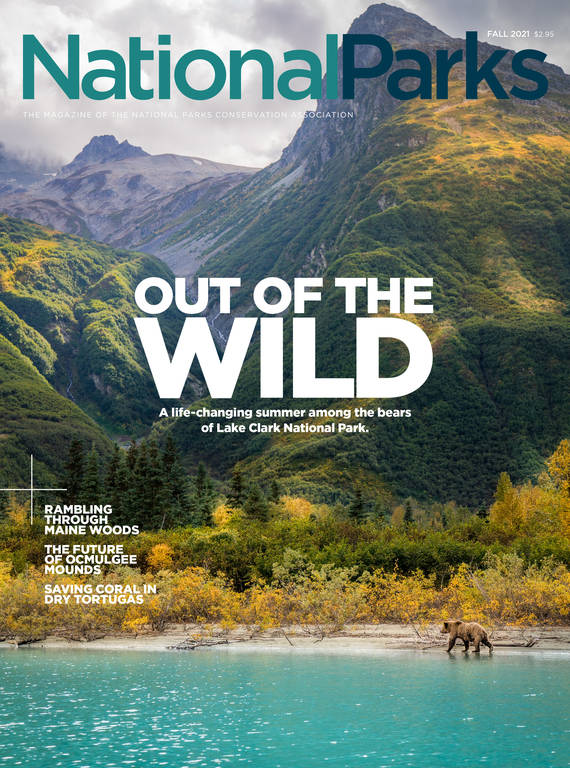Fall 2021
Coral Calamity
A disease is wreaking havoc on coral colonies in Dry Tortugas and beyond. But hope is on the horizon.
The May 29 monitoring excursion started like any other for members of Dry Tortugas National Park’s Coral Response Team. The sky was clear and bright, the ocean calm. The ambient temperature, a balmy 80 degrees, matched that of the water. With captain Emily Dropiewski at the helm of the park’s 25-foot Boston Whaler, they cruised to their first dive site. Much as they had for the last eight months, they strapped on their tanks, popped in their regulators, stepped off the boat and swam as deep as 60 feet to inspect the reef. Late in the afternoon, after examining 27 colonies, biological science technician Melissa Heres noticed something that gave her pause. She waved over coral biologist Rachel Johns for a second opinion.
Standing out from the surrounding multi-hued corals was a foreboding blotch. Even to an untrained eye the bone-white lesion would be cause for concern. The team’s worst fears had been realized: Stony coral tissue loss disease had arrived in Dry Tortugas. By the time they’d finished surveying the area the following day, the tally of infected colonies had crept up to 11. “It’s heartbreaking,” said Clayton Pollock, a fisheries biologist at the park.
The outbreak wasn’t completely unexpected. Dry Tortugas’ coral colonies constitute the western extent of the Florida Reef Tract, a 360-mile boomerang of coral formations that trace the Florida Keys and stretch all the way to the waters north of Biscayne National Park. Since rearing its head offshore of Miami in 2014, stony coral tissue loss disease has spread with alarming speed. Its eventual appearance in the aquamarine waters of Dry Tortugas seemed a near inevitability.
As soon as the disease was confirmed, park staff literally dove into action, outlining the affected areas in antibiotic paste, like crudely applied caulk. The process is time intensive, requiring scuba gear and lesion-by-lesion application. And the medicine is far from a panacea. It stops an active lesion from inflicting further harm, but it doesn’t protect a colony from a new infection and can’t reverse existing damage. That said, it’s the most effective treatment identified, according to Florida’s coral disease response coordinator, Maurizio Martinelli, who called this particular malady “probably the worst coral disease we have ever seen anywhere.” It’s affected more than 20 of the 40-odd reef-building coral species within the Florida Reef Tract, killing coral reefs that predate the Industrial Revolution, and now extends across the Caribbean, from Belize to Virgin Islands National Park.
Coral reefs, often called the rainforests of the sea, are the workhorses of the ocean. A significant portion of all marine life uses these fantastical underwater habitats either as nurseries or feeding grounds. The reefs develop over thousands of years, starting with a single coral polyp. They grow slowly, layer upon layer, with live coral rooting to the limestone skeletons of past corals. The result is a warren of nooks, crannies and passageways, ideal cover for myriad critters, including eels and lobsters. Reefs also benefit people, buffering coastal areas from powerful storm surges and sustaining livelihoods via fishing and tourism.
Unfortunately, a number of stressors — from warmer, more acidic oceans and pollution to improper boat anchoring and unsustainable fishing — have left many reefs teetering on the brink of collapse. Scientists estimate that 50% of the world’s coral reefs have disappeared in the last 30 years alone, and the future looks just as bleak. Corals may completely die out in the next 50 to 100 years if we don’t get a handle on climate change, said Melissa Abdo, director of NPCA’s Sun Coast region. “That’s a horrible, dismal fact,” she said. “Immediate climate action is needed if our grandkids are to be able to swim amidst coral reefs, as I did as a kid.”
Because the Florida Reef Tract spans many jurisdictions, including national parks, national marine sanctuaries and state waters, more than 60 groups and agencies are working together to address the threat of the stony coral tissue loss disease there. The response effort consists of eight working groups, all tackling the problem from different angles. Together, scientists, citizens, government agencies, universities and nonprofits are researching the disease and its treatments, educating boaters and divers, increasing monitoring, and conducting hands-on restoration. Aquariums across 14 states also play a role, housing genetically diverse colonies from Biscayne, Dry Tortugas and elsewhere, in preparation for the day samples can be transplanted back into the wild.
Already, partner groups have returned nearly 6,000 coral fragments to locations where the disease has passed its peak in a massive experiment overseen by the Florida Fish and Wildlife Conservation Commission. “It’s a very ambitious project,” said Marina Garmendia, who performs data collection for four of the 24 transplant sites in her role as graduate research assistant at Nova Southeastern University. Researchers affixed five diminutive discs of knobby brain, mountainous star or great star coral to more than 1,100 concrete bases placed throughout the Florida Reef Tract. The hope is that each base’s corals, which Garmendia said currently resemble “very small cookies,” will fuse together to form new colonies. But that will take years. In the near term, information gleaned during monthly monitoring will guide future restoration decisions.
Martinelli said the collaborative nature of this disease response effort gives him hope. “It’s not just a single group that’s trying to do this,” he said. “It’s so many people across the state who have come together to say, ‘We’re going to stand up against this,’ in a way that we’ve never done before.”
The outlook might be guarded, but Martinelli is convinced the Florida Reef Tract will survive. “This disease is not the end of the reef as we know it,” he said. “But it is going to take a lot of time and energy and effort.”
What You Can Do to Protect Coral
Boat, fish and recreate responsibly. Know the regulations and stay abreast of best practices, such as avoiding contact with coral and cleaning your snorkel, dive and boat gear between uses.
Be an informed consumer. Consider mineral-based, reef-safe sunscreens, minimize purchases with plastic packaging and opt for sustainably caught fish.
Subscribe toNational Parks
You can read this and other stories about history, nature, culture, art, conservation, travel, science and more in National Parks magazine. Your tax-deductible membership donation of $25 or more entitles…
See more ›Conserve water. The adage that all drains lead to the ocean still applies, even if you live hundreds of miles away. Doing your part to minimize wastewater and limit pollution in your runoff will ultimately benefit coral reefs. (Martinelli suggests investing in low-flow showerheads, turning off the tap when you brush your teeth, landscaping with native shrubs, flowers and trees, and applying pesticides and fertilizers judiciously. Abdo goes one step further and proposes forgoing lawn chemicals altogether as directed by many municipalities.)
Lower your carbon footprint. As oceans absorb more atmospheric carbon dioxide, the water becomes more acidic, which impedes coral’s ability to grow the skeletons that form the foundation of healthy reefs.
Support NPCA’s campaign to establish a marine reserve at Biscayne National Park, where decades of over-harvesting have decimated the fish populations. NPCA staff have worked for the last 20 years to designate a portion (just 6%) of Biscayne’s waters as off-limits to fishing. Reserves are a proven way to boost the health of marine ecosystems, allowing both fish and coral species to rebound. Though the Park Service decided years ago to establish the reserve, it has yet to implement it.
About the author
-
 Katherine DeGroff Associate and Online Editor
Katherine DeGroff Associate and Online EditorKatherine is the associate editor of National Parks magazine. Before joining NPCA, Katherine monitored easements at land trusts in Virginia and New Mexico, encouraged bear-aware behavior at Grand Teton National Park, and served as a naturalist for a small environmental education organization in the heart of the Colorado Rockies.




